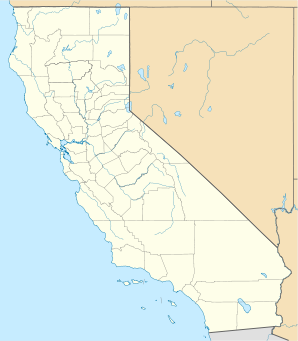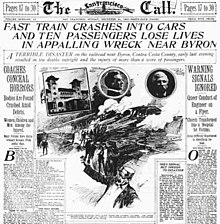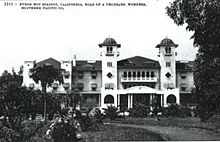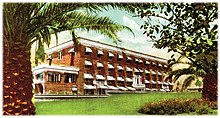Byron (California)
| Byron | ||
|---|---|---|
 |
||
| Location in California | ||
|
|
||
| Basic data | ||
| State : | United States | |
| State : | California | |
| County : | Contra Costa County | |
| Coordinates : | 37 ° 52 ′ N , 121 ° 38 ′ W | |
| Time zone : | Pacific ( UTC − 8 / −7 ) | |
| Residents : | 916 (status: 2000) | |
| Population density : | 138.8 inhabitants per km 2 | |
| Area : | 6.6 km 2 (approx. 3 mi 2 ) of which 6.6 km 2 (approx. 3 mi 2 ) is land |
|
| Height : | 10 m | |
| Postal code : | 94514 | |
| Area code : | +1 925 | |
| FIPS : | 06-09346 | |
| GNIS ID : | 0238290 | |
 Byron (California) |
||
Byron is a census-designated place in Contra Costa County in the US state of California , United States , which was founded in 1876. It has a size of 6.6 km² with 916 inhabitants (as of 2000). Byron is mainly influenced by the agriculture of the surrounding Central Valley . At the beginning of the 20th century, Byron was a well-known health resort and was also called the " Carlsbad of the West ".
location
Byron is located approximately 70 km east of San Francisco , at the southern end of the Sacramento-San Joaquin River Delta . At the south end of Byron is the Clifton Forebay , both the California Aqueduct - which supplies large parts of the Central Valley and Los Angeles with drinking water - and the South Bay Aqueduct - which leads to the Silicon Valley and the San Francisco Bay Area - are from dined here.
Byron Airfield (C83) is home to Bay Area Skydiving - the largest parachute club in the San Francisco Bay Area - and the Patriots Jet Demonstration Team , the only private jet aerobatic team in the United States.
history
Byron was founded in 1876 as a train station for the Southern Pacific Railroad on the San Jose - New Orleans route . For the surrounding farms, the train station offered an alternative to the steam ships operating in the delta for the transport of agricultural products - mostly tropical fruits , fruit , asparagus or olives , and therefore quickly developed into a transshipment point. In 1902 there was a railway accident in which 28 people died.
Byron Hot Springs
As early as 1863, John Risdon from Saline (Michigan) had acquired a plot of land near Byron (which was not yet founded at the time), on which there were mineral and sulphurous thermal springs . Originally, these sources were supposed to be used for salt production, but this was uneconomical due to the high transport costs overland. However, as more and more squatters settled in the area around the springs, some buildings were built on the site, which were then gradually expanded into a spa . Among other things, bathhouses were built for the various springs, a swimming pool 15 m long - called the gas plunge - was dug, and the first overnight accommodation was created.
In 1878 the first hotel, a three-story building, was built along with several cottages . Most of the plant burned down in 1901. In 1902 the new building opened, which the architect James W. Reid (who had worked on the Fairmont Hotel , among other things ) had designed. In addition to the hotel facilities, it had a doctor's office, post office, and telegraph and telephone stations. This building burned down completely in July 1912.
In 1914 a new building was opened, which was built in brick construction to this day. The popularity of the resort rose steeply, Byron Hot Spring became famous as the Carlsbad of the West . In the “ Roaring Twenties ”, many Hollywood stars, top athletes and other celebrities were regular guests at the hotel, including Charlie Chaplin , Clark Gable , Jack London , Rudolph Valentino , Mae West , President James Garfield and the San Francisco Seals baseball team .
Due to the Great Depression in 1929, visitor traffic fell sharply in the 1930s, and the resort slowly fell into disrepair due to inheritance disputes until it was practically abandoned in 1939.
Camp Tracy
In 1942, the forerunner of the CIA , the Office of Strategic Services , rented the site as an "Interrogation Center" on behalf of the US Army - a top-secret facility that was supposed to interrogate German and Japanese prisoners of war during World War II . The facility was called "Camp Tracy," it was one of two such agencies in the United States, the other was Fort Hunt in Alexandria, Virginia on the east coast .
Since the purpose of the camp violated the Geneva Conventions , it was declared a “transit camp ” ( processing station ) in which the prisoners were only temporarily housed before they were transferred to their POW camps.
The prisoners were treated very generously at Camp Tracy, there was good food, plenty of entertainment and also free time in the surrounding villages. However, the entire facility was bugged and spies working for the OSS were mixed with the prisoners and "secret" opportunities for contact were created between the prisoners. This was intended to "loosen the tongue" of the prisoners, a technique that was adopted by the British secret service. Through the complete monitoring, this was recorded and used by the intelligence service . In 1944 921 Japanese and 645 German prisoners were interrogated here. There are still references to the wiretapping systems, such as B. Microphone wires in sockets and sockets, which lead through the elevator shaft into a basement room.
After Camp Tracy was no longer needed by the US Army in 1945, it was returned to the original owners, who then sold it to the Greek Orthodox Church . They wanted to use the site as a monastery , and in 1948 it was consecrated as Mission St. Paul . However, the plans were never fully implemented and the site was sold again in 1956. Since then there have been and have been efforts to restore the site to its former glory, which, however, repeatedly run into the sand.
On July 25, 2005, a historic auxiliary building burned down completely, and the main building also suffered some damage.
literature
- Carol A. Jensen: Byron Hot Springs (CA) (Images of America) . Arcadia Publishing, 2006, ISBN 978-0-7385-4700-8 .
Web links
- Byron Airport Official Website (English).
- Byron Hot Springs website (Engl.)
- Bay Area Skydiving (Engl.)
- Patriot Jet Team (Engl.)
Individual evidence
- ^ Steel, Steam and Blood: The Great Byron Train Disaster . William Mero. Retrieved December 15, 2010.
- ↑ Roaring '20s: Mecca for Hollywood Stars . Byron Hot Springs. Retrieved December 15, 2010.
- ^ A b Byron Hot Springs Interrogation Center . US Army Corps of Engineers. Retrieved December 15, 2010.
- ^ A b In the shadows of Camp Tracy . The Oakley Press. Retrieved on December 15, 2010. ( Page no longer available , search in web archives ) Info: The link was automatically marked as defective. Please check the link according to the instructions and then remove this notice.
- ^ WWII Internment Camp . Byron Hot Springs. Retrieved December 15, 2010.
- ↑ FIRE HITS BYRON HOT SPRINGS . Contra Costa Times. Retrieved December 15, 2010.





